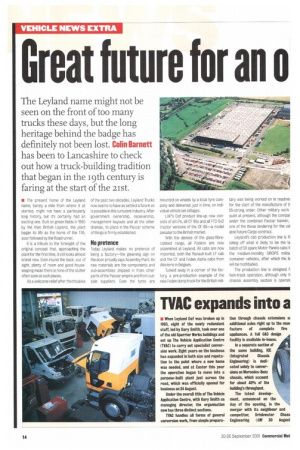TVAC expands into a 'me to handle a range of roles
Page 14

Page 15

If you've noticed an error in this article please click here to report it so we can fix it.
w When Leyland Daf was broken up in 1993, eight of the newly redundant staff. led by Gary Smith. took over one of the old Spurrier Works buildings and set up The Vehicle Application Centre (TVAC) to carry out specialist conversion work. Eight years CM the business has expanded in both size and reputation to the point where a new home was needed, and at Easter this year the operation began to move into a purpose-built plant just across the road, which was officially opened for business on 24 August.
Under the overall title of The Vehicle Application Centre, with Gary Smith as managing director, the organisation now has three distinct sections.
TVAC handles all forms of general conversion work, from simple prepara
tion through chassis extensions al additional axles right up to the man facture of complete tire appliances, A full CAD design facility is available in-house.
In a separate section of the same building, ICE (Integrated Chassis Engineering) is dedicated solely to conversions on Mercedes-Benz chassis, which account for about 40% of the building's throughput.
The latest development, announced on the day of the opening, is the merger with its neighbour and competitor, Drinkwater Chass Engineering (CM 30 August
ptember). The plan now is for the ilufacture of fire appliances to be concentrated in the old building, while ICE and TVAC's heavier conversions will occupy the new building. Conversions on lighter vehicles will be largely concentrated at Drinkwater. The work in progress during CM's II1 visit was varied, and was typical of the firm's portfolio, which includes work for all of the chassis manufacturers to varying extents. In terms of volume the main task is the ii al preparation of Daf 85 CFs for the y il Mail and Parcetforce. Although lit
tle major engineering work is involved, each one requires the addition of more than 1,000 part numbers to bring the standard vehicle up to the operator's road-ready requirements.
A batch of Shell-liveried Renault Premiums were being kitted out with Pet-Reg equipment; an ERF ECS was being prepared as a fire appliance for Buckinghamshire Fire and Rescue; and a John Lewis Oaf 85 CF was being fitted with a Frigoblock unit.
At the smaller end of the market there were a number of lsuzu NQR school buses being retrofitted with air suspension, while the finishing touches were being put to the fifth-wheel subframe for the first Mercedes-Benz Sprinter 416 mini-artic. One worryinglooking job was the addition of a sur
prisingly large number of raising blocks to the rear of a left-hand-drive Oaf 45 IF, until we realised it was destined to become a Scarab road sweeper. The neighbouring ICE workshop was largely taken over by the major project to supply 52 Atego 6x2 rear-steer 21-tonners for Coca Cola's urban delivery fleet, with various other smaller-scale jobs passing through.
When speaking to representatives of various chassis manufacturers at the opening ceremony, the high level of respect already accorded by the industry to the TVAC operation was evident. The latest investment in the new facility can only help with the presentation of a more professional image in a sector which is often still criticised for its cottage industry" approach.




































































































































